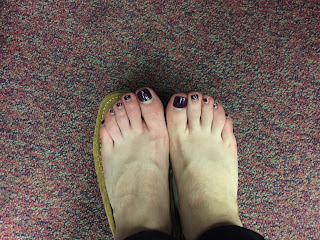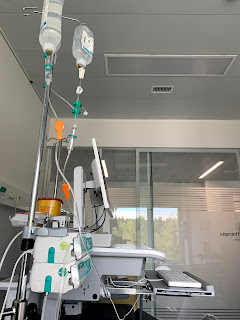My second neuropathy flare after almost 4 years in remission
In this post I'll write some more of my story with autoimmune small fiber neuropathy. I wrote in one of my last posts, that prednisone had gotten my small fiber neuropathy into remission back in 2014. For months after this, I was worried that my symptoms would come back any second. Particularly, whenever I had a cold, because this is what triggered my neuropathy in the first place.
But time passed and nothing happened. And as the years went by I became more and more confident that maybe this was just a one time reaction to a virus. After all, there were quite a few reports out there of patients with a so called 'monophasic' flare of post-viral small fiber neuropathy, which disappeared after some sort of immunotherapy.
So I went about my life normally again, and I applied for a scholarship to do a postdoctoral fellowship in Boston. I've always wanted to live and work abroad for a while, and after experiencing how quickly things can become physically impossible, I figured I better not wait too long.
Turns out I got the scholarship. 🌺 The only downside to this was that Steve and I had originally planned to go to Boston together, but then he got a new job which he liked in Switzerland in early 2016, so we decided that it was better if he stays in Switzerland and we'd both go a bit forth and back. Steve managed to get some prolonged unpaid holidays and I was quite flexible to spend time in Switzerland as well, as I was paid by my own scholarship anyway.
Flare two started out of the blue while I was in Boston
So in April 2016, I moved to Boston for a 2-year postdoc at a research group at the Harvard Medical School, which is affiliated with some large hospitals in the area. I spent 2016 and 2017 there and I really loved the city. Steve spent both summers there with me and we traveled up to Maine, New Hampshire and Vermont and discovered the area.
In fall 2017, my time there came to an end and I planned to move back to Switzerland in early December 2017. In mid October, I caught a cold and was feeling a bit under for a few days, but it wasn't anything major and I didn't think much of it. About 4 days into my cold I went and got the flu shot, since I was feeling fine enough and figured I better get that done.
About a week after my cold, a tingle in my foot started
But then about a week after my cold and about 2 or 3 days after my flu shot, I noticed this subtle tingle and odd feeling in my left forefoot. It was really nothing much at that time but somehow I instantly had a bad gut feeling and it kind of stressed me out.
I'd had several moments when I had gotten stressed out about some odd sensations over the past years, but usually the symptoms dissolved and I was able to relax again. So I told myself that surely this is just me stressing and over-focusing, and that this would just pass.
But somehow I couldn't get over it. This tingle and odd feeling lasted for about 4 days. It was a nice long fall weekend in New England and about 4 days into these symptoms I went on a trip to New Hampshire for a hike to see the nice foliage during Indian summer with friends.
This is us sitting on top of the hill we climbed looking over the beautiful scenery. We walked up and downhill on hiking trails for about 3 hours, and although I could feel this odd tingle in my foot I wasn't actually in pain or anything. It just kind of felt like something wasn't right.
Symptoms were a bit stronger after the hike
When I arrived back at my apartment and took off my shoes, I felt that the tingle in my foot had started to get stronger and I started to really freak out. I hadn't mentioned my worries to anyone because I tried to tell myself that it was absolutely nothing. But as I sat in my apartment by myself, I realized that something probably wasn't right and I called Steve, who was back in Switzerland at that time. I told him that I was freaking out because I was worried that my neuropathy was about to come back.
Obviously that then freaked Steve out, because we both did not expect this and obviously 2014 was also kind of traumatizing for him. Given that he was back home, there was really not that much he could do at this point, so he recommended I just take a sleeping pill (luckily I had some of those to deal with an occasional jet lag) and go to bed. I think we just both hoped I would wake up and it was just a bad scare. So that's what I did: I went and passed out.
I woke up in pain and full body discomfort
But the moment I woke up the next morning I knew I had a problem. My feet were tingly and sore and my hands felt like they had this electric layer all over them. On top of that my nose was really itchy and basically my whole body felt itchy. Within a day, all my symptoms I'd had in 2014 were back full blown. 😩😩😩😩😩😩
- My feet were sore and tingly and putting on shoes was painful
- The bottoms of my feet felt like I was walking on gravel
- My fingers were sore and felt like they had an electric layer on them
- My nose was itchy and felt as though I had to sneeze
- My arms and legs just felt itchy all over and scratching didn't help at all
- My feet would turn red (erythromelalgia) whenever I walked or was a bit warm, like you see in the picture below. This is literally after walking for a couple of minutes and its really sore.
I had never been to a doctor in the US
It's one thing to have neuropathy coming back, but it's a whole other story to have this happening while living abroad by yourself with travel health insurance only. I had kept my main health insurance in Switzerland and planned to just go to the doctor whenever I was there. So obviously I had never been to a doc in the US. Had I been back home in Switzerland, I would have called Dr. Soland and could probably have seen him the next day to figure out how to go about this.
For a second, I literally contemplated to book a flight and to just fly back the same day before it got worse. But then I figured that this would just get super complicated, as I was going to move back home in 6 weeks anyway and would have to clear my apartment etc.
After all, I sort of knew what to do; I had to start prednisone treatment as soon as possible and hopefully symptoms would resolve soon. Being a pharmacist, I actually carried a load of prednisone with me wherever I went anyway since my first flare in 2014.
Plus, I was in THE medicine city. Boston is probably the city with the highest density of medical specialists in the world, and I was working at one of the best hospitals in the world. So if anywhere, this was the place where I could get really good care by specialists. I just had to make an extra effort to find my way around the system in a moment when I already felt super beat down.
I knew one of the neuropathy experts worked at my hospital
During my first flare in 2014, I had to do a lot of literature research to find out what I had. During this literature search, I came across some publications by Prof. Maryanne Walker (not her real name), who is one of the few neurologists who is specialized in autoimmune small fiber neuropathy.
Coincidence had it, that I actually worked at the same hospital as Prof. Walker, so I thought surely it must be possible for me to see her. BUT.....I underestimated American bureaucracy.....🤯🤯 If you think Switzerland is a bureaucratic country, let me tell you, the Americans have taken bureaucracy to the next level.😂
Naively, I just called Prof. Walker's office and asked if it was possible to see her. There was a lady on the phone who told me that generally Prof. Walker was not accepting new patients and that if I was an emergency, I'd have to get referred by my primary care physician.
I had to find a primary care physician
Fair enough, it's standard in Switzerland as well that you have to get referred to a specialist by your primary care physician, but the problem was that I had no primary care physician and turns out it's almost impossible to find one.
I asked some of my work friends and called their primary care clinics to see if I could come in, but all of them told me that they didn't accept new patients, or that I could get an appointment in 3 months or something.
After a day of research, I found a walk in primary care clinic, which is run by one of the large hospitals. This clinic was downtown and it was a lot more fancy than any primary care clinic I had ever seen in Switzerland. I was brought into my own shiny room where I even had my own huge TV to entertain me while I waited.
After a while a nurse practitioner came in and asked me why I was there. So I told her about my symptoms and my history of post-viral small fiber neuropathy. She did some very basic neuro exams, and like always could find nothing wrong. She had obviously never heard of my illness, so I asked her to prescribe prednisone and to refer me to Prof. Walker, which she did.
I never actually saw a physician during this visit but later got a bill of about 400 USD for a 10 minute consultation and a prescription....oh well🙃
I was told that my referral should be through within 2-3 days and that I will get a call by the hospital. I was explicitly told I did not have to call and that I will be contacted at the latest within a week. But experience taught me that these things tend to not work as promised, so I was ready to stalk the c..... out of this hospital until they give me an appointment....and let me tell you.....it was A HASSLE but I managed.👻
Alright, this post hast gotten kind of long already, so I will continue next time. Spoiler alert: I did actually manage to see Prof. Walker and in hindsight I'm very thankful for the fact that I did stay and fight through the bureaucracy jungle.
And meanwhile I wish you all a good start into the week. Thank you all for reading my blog. 🌺
 Follow on Instagram
Follow on Instagram












